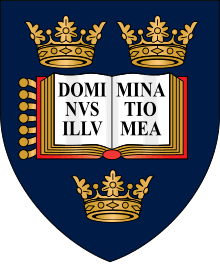Harris Manchester College, Oxford
| Harris Manchester College | ||||||||||||||||
|---|---|---|---|---|---|---|---|---|---|---|---|---|---|---|---|---|
| Oxford | ||||||||||||||||
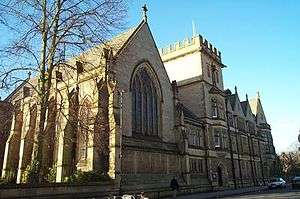 | ||||||||||||||||
 Blazon: Gules two torches inflamed in saltire proper, on a chief argent, between two roses of the field barbed and seeded, an open book also proper. | ||||||||||||||||
|
| ||||||||||||||||
| Coordinates | 51°45′21″N 1°15′07″W / 51.755758°N 1.252044°WCoordinates: 51°45′21″N 1°15′07″W / 51.755758°N 1.252044°W | |||||||||||||||
| Full name | Manchester Academy and Harris College | |||||||||||||||
| Latin name | Collegium de Harris et Manchester | |||||||||||||||
| Motto | Veritas Libertas Pietas (Truth, Freedom, Piety) | |||||||||||||||
| Established | 1786 | |||||||||||||||
| Named for | Philip Harris, Baron Harris of Peckham | |||||||||||||||
| Sister college | Homerton College, Cambridge | |||||||||||||||
| Principal | Prof Jane Shaw | |||||||||||||||
| Undergraduates | 108[1] (2017/2018) | |||||||||||||||
| Postgraduates | 145 | |||||||||||||||
| Website |
www | |||||||||||||||
| Map | ||||||||||||||||
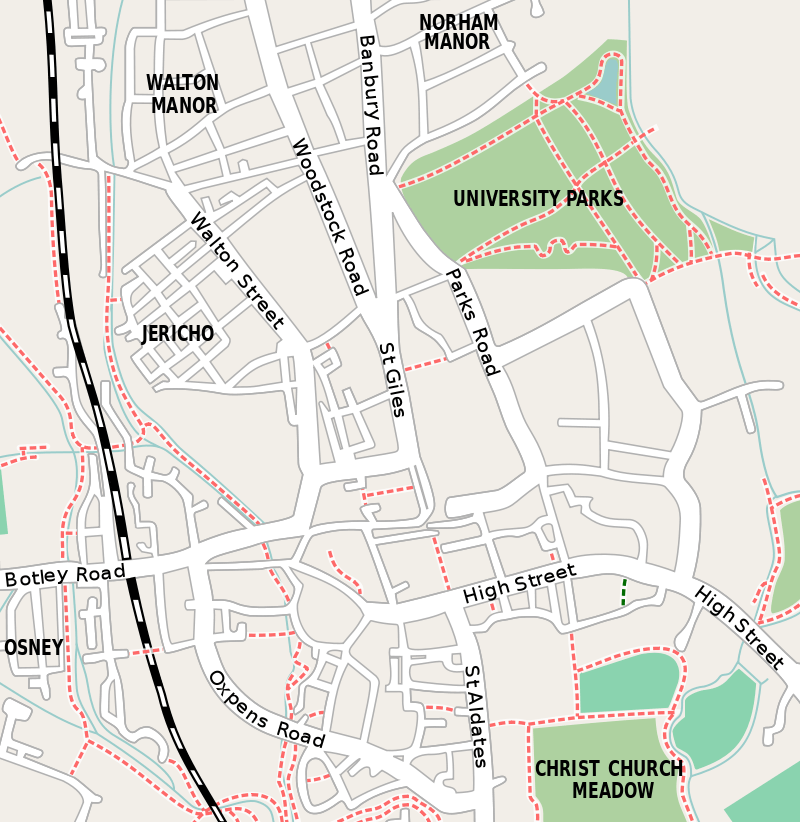 Location in Oxford city centre | ||||||||||||||||
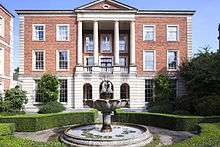
Harris Manchester College is a constituent college of the University of Oxford in the United Kingdom. Formerly known as Manchester College, it is listed in the University Statutes (V.1) as Manchester Academy and Harris College, and at university ceremonies it is called Collegium de Harris et Manchester. Located in Mansfield Road in central Oxford, Harris Manchester is one of very few mixed-sex higher education colleges in the UK whose undergraduate places are exclusively for students aged 21 years or over. The Principal of the college is the historian Prof Jane Shaw.
History
Foundation and relocation
The college started as the Warrington Academy in 1757 where its teachers included Joseph Priestley,[2] before being refounded as the Manchester Academy in Manchester in 1786.[3] Originally run by English Presbyterians, it was one of several dissenting academies that provided religious nonconformists with higher education, as at the time the only universities in England – Oxford and Cambridge – were restricted to Anglicans. It taught radical theology as well as modern subjects, such as science, modern languages, language, and history; as well as the classics. Its most famous professor was John Dalton, developer of atomic theory.
The college changed its location five times before settling in Oxford. It was located in Manchester between 1786 and 1803. It moved to York until 1840. It was located at 38 Monkgate, just outside Monkbar; later this was the first building of the College of Ripon and York St John (now York St John University).The key person in York was Charles Wellbeloved, a Unitarian minister. Because he would not move to Manchester, the college moved to York to have him as head. At first he taught all subjects, but hired additional tutors after a year. He always worked hard and several times his health broke. Wellbeloved did not allow the school to be called Unitarian because he wanted students to have an open mind and to discover the truth for themselves. In 1809 he wrote to George Wood,
I do not and will not teach Unitarianism or any ism but Christianism. I will endeavour to teach the students how to study the Scripture—nice if they find Unitarianism there—well if animism—well if Trinitarianism—well, only let them find something for themselves.
Under Wellbeloved's principalship 235 students were educated at the college: 121 divinity students and 114 laymen. Of the former, 30 did not enter the ministry and five entered the Anglican priesthood. Among the lay students were scholars, public servants, businessmen, and notable men in the arts. The majority was Unitarian.
In 1840, when age forced him to retire, the college moved back to Manchester, where it stayed until 1853.[4] In 1840, the college started an association with the University of London, and gained the right to present students for degrees from London. Between 1853 and 1889 the college was located in London, in University Hall, Gordon Square.[5] From London it moved to Oxford, opening its new buildings designed by the Unitarian architect Thomas Worthington in 1893.
Social reform
In its early days, the College supported reforming causes, such as the abolition of slavery (1778), and the repeal of the Test Act (1828) and the Corporation Act (1828). In the 1920s and 1930s, the College provided courses for the Workers' Educational Association.
Women were permitted to attend some lectures in college from 1876, and in 1877, the College set up a series of examinations in theology, which could be taken by women as well as men.[6] In 1901, Gertrude von Petzold graduated from her training at Manchester College to become a minister in the Unitarian church- the first woman to be qualified as a minister in England.[7] This was possible despite the fact that Oxford University did not formally accept female students or award them degrees until 1920 because Manchester College was at that time associated with the University of London, which in 1878 became the first UK university to award degrees to women[8].
Modern day

Manchester College became a permanent private hall of Oxford University in 1990 and subsequently a full constituent college, being granted a Royal Charter in 1996.[9] At the same time, it changed its name to Harris Manchester College in recognition of a benefaction by Philip Harris, Baron Harris of Peckham.
Today the college accepts 'mature students' only, that is, students above the age of 21, both for undergraduate and graduate studies. The college tries to continue its liberal and pioneering ethos, considering its mature student focus as a modern means of providing higher education to those that have been excluded from it in the past.
The college is also the base for the Farmington Institute for Christian Studies which aims to support, encourage and improve Christian education in schools, colleges and universities.
Student life
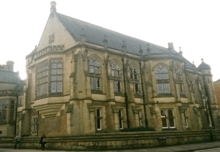
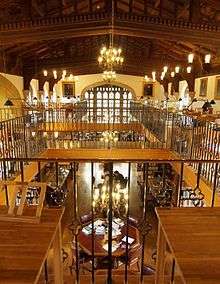
Despite the small student body, the college offers a wide array of courses and has a very international atmosphere. Many undergraduate tutorials are carried out in the college, though for some specialist papers undergraduates may be sent to tutors in other colleges.
Members are generally expected to dine in the Arlosh Hall, where there is a twice-weekly formal dinner at which students dress in jackets, ties, and gowns.
The college is also the home of a chapel with ornate wood carvings, an organ, and notable stained-glass windows by the Pre-Raphaelite artists Sir Edward Burne-Jones and William Morris. Reflecting the college's religious roots, the Unitarian-affiliated Manchester College Oxford Chapel Society meets on Sundays.
Sports
Aside from the college punt, The Royle Yacht, and a croquet lawn and fishing fountain, the college has no real sports facilities. However, the college does consistently enter a football team into the university leagues, and members do routinely join teams from other colleges, most recently providing several members of the Brasenose Rugby team and the Wadham and St Hugh's football teams. All members of the college have access to the gym and spa at the Oxford Spires Four Pillars Hotel[10] as well as the Oxford University pool on Iffley Road.
In recent years the college's ice hockey team has been successful, once winning second place in the intercollegiate cuppers tournament, with the Basketball team winning third place in its intercollegiate cuppers tournament the year before. There is also an active pool team who play in the second tier of the intercollegiate competition and a thriving squash club.[11]
Harris Manchester also has an affiliation with neighbouring Wadham College for those interested in becoming members of Wadham College Boat Club, which came in second in the 2012 Women's Torpids and Summer VIIIs, and saw both the First and Second Men's boats winning blades.
Junior Common Room (JCR) Bar
Harris Manchester has one of the three remaining student run college bars in Oxford (the others being Balliol College and St Cross College).[12] Recently refurbished, the bar offers some of the lowest prices in Oxford and boasts a particularly strong selection of single malt whiskies.
The Tate Library
Despite being the smallest college of Oxford University, Harris Manchester boasts the sixth largest college library and offers the best student population to book ratio. It houses a collection of books and manuscripts dating back to the fifteenth century. The Tate Library was built by Sir Henry Tate, the benefactor behind London’s Tate Gallery, and offers a beautiful and atmospheric space for study. The library was expanded in 2011 with the addition of a gallery, which blends in seamlessly with the Victorian Gothic architecture. The library is well stocked in all the major subjects offered by the college including English Literature, Philosophy, Theology, Politics, Economics, Law, History and Medicine. It also holds a significant collection on the history of Protestant dissent in England and is home to the Carpenter Library of World Religions, donated to the college by its former principal, J. Estlin Carpenter.
Harris Manchester College is also located in convenient proximity to the Bodleian Library, the main research library of Oxford University, as well as the English, History, Social Sciences, and Law faculty libraries.
Gallery
- Clock tower
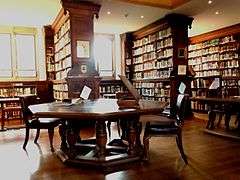 Tate Library
Tate Library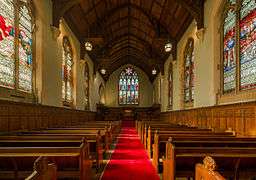 College chapel
College chapel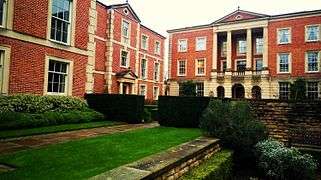 College grounds
College grounds Dining hall
Dining hall Exterior of chapel
Exterior of chapel
Notable people
Academics/teachers
- Prof Jane Shaw, Principal
People associated with Harris Manchester
- Joseph Priestley, credited with discovery of oxygen
- James Martineau, later the Principal of his alma mater
- Joseph Lupton, President of the college
- John James Tayler
- Peter Finch Martineau, Vice-President of the college (1815–34)[13]
- Francis William Newman
- Charles Wellbeloved
- Thomas Percival
Fellows of the College
- Andrew D. Hamilton, President of New York University
- Roger Bannister, first man to run a sub-four-minute mile
- Peter Cruddas, former Conservative party co-treasurer
- Raymond Plant, Baron Plant of Highfield
- Kate Pretty CBE, former Principal of Homerton College, Cambridge
- Geoffrey Ma, Chief Justice of the Court of Final Appeal of Hong Kong
- William L. Swing, Director-General of the International Organization for Migration
- Alister McGrath Theologian
- Terezinha Nunes, psychologist and Professor of Educational Studies
Alumni
- Oliver Popplewell, judge of the High Court of England and Wales
- Lord Nicholas Windsor
- Jocelyn Davies AM
- Íngrid Betancourt, Colombian politician, former senator and anti-corruption activist
- Maurizio Molinari, journalist, writer, and foreign correspondent
- Sandra Gregory
- Joe Roff, international rugby player
- Dwayne Whylly, Bahamian national football team goalkeeper
- Lanto Sheridan, international polo player
- Karen Harrison, first female train driver in Britain
References
- ↑ "Student statistics". University of Oxford. 2017. Retrieved 31 August 2018.
- ↑ "About the College - History". Harris Manchester College, University of Oxford. Archived from the original on April 21, 2015. Retrieved May 11, 2015.
- ↑ University of Oxford: Graduate Studies Prospectus - Last updated 17 Sep 08
- ↑ "Charles Wellbeloved". uua.org. Archived from the original on 2006-09-22. Retrieved 2006-09-24.
- ↑ "University Hall (Dr. Williams' Library), Gordon Square - British History Online". www.british-history.ac.uk.
- ↑ Communication from Susan Killoran, college librarian
- ↑ "Gertrude von Petzold" (PDF).
- ↑ "History of University of London". University of London. Retrieved 2018-05-04.
- ↑ www.hmc.ox.ac.uk Archived 2015-04-21 at the Wayback Machine.
- ↑ "Oxford Gym and Leisure Facilities - Oxford Spires Four Pillars Hotel". Archived from the original on 2013-04-20. Retrieved 2012-06-06.
- ↑ "College Pool League - Oxford University Pool & Snooker Club". www.oupsc.co.uk.
- ↑ "Archived copy" (PDF). Archived from the original (PDF) on 2015-09-24. Retrieved 2014-02-04.
- ↑ Ronalds, B.F. (February 2018). "Peter Finch Martineau and his Son". The Martineau Society Newsletter. 41: 10–19.
Further reading
- A Fine Victorian Gentleman: The Life and Times of Charles Wellbeloved by Frank Schulman, published by Harris Manchester College 1999. Pages 55–89 cover Wellbeloved's period as principal of Manchester College, York.
External links
| Wikimedia Commons has media related to Harris Manchester College, Oxford. |
